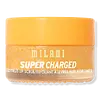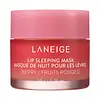What's inside
What's inside
 Key Ingredients
Key Ingredients

 Benefits
Benefits

 Concerns
Concerns

 Ingredients Side-by-side
Ingredients Side-by-side

Sucrose
HumectantHelianthus Annuus Seed Oil
EmollientRicinus Communis Seed Oil
MaskingPolybutene
Helianthus Annuus Seed Wax
Skin ConditioningSilica
AbrasiveDiisostearyl Malate
EmollientArgania Spinosa Kernel Oil
EmollientCocos Nucifera Oil
MaskingRosa Canina Fruit Oil
EmollientSiraitia Grosvenorii Fruit Extract
Skin ConditioningPrunus Amygdalus Dulcis Oil
Skin ConditioningCurcuma Longa Root Extract
MaskingPanax Ginseng Root Extract
EmollientCitrus Reticulata Fruit Extract
Skin ProtectingSynthetic Wax
AbrasiveIsopropyl Titanium Triisostearate
EmollientPhenoxyethanol
PreservativeAroma
Benzyl Benzoate
AntimicrobialCitral
PerfumingLimonene
PerfumingLinalool
PerfumingCinnamal
PerfumingIron Oxides
CI 19140
Cosmetic ColorantSucrose, Helianthus Annuus Seed Oil, Ricinus Communis Seed Oil, Polybutene, Helianthus Annuus Seed Wax, Silica, Diisostearyl Malate, Argania Spinosa Kernel Oil, Cocos Nucifera Oil, Rosa Canina Fruit Oil, Siraitia Grosvenorii Fruit Extract, Prunus Amygdalus Dulcis Oil, Curcuma Longa Root Extract, Panax Ginseng Root Extract, Citrus Reticulata Fruit Extract, Synthetic Wax, Isopropyl Titanium Triisostearate, Phenoxyethanol, Aroma, Benzyl Benzoate, Citral, Limonene, Linalool, Cinnamal, Iron Oxides, CI 19140
Diisostearyl Malate
EmollientHydrogenated Polyisobutene
EmollientPhytosteryl/Isostearyl/Cetyl/Stearyl/Behenyl Dimer Dilinoleate
Skin ConditioningHydrogenated Poly(C6-14 Olefin)
EmollientPolybutene
Microcrystalline Wax
Emulsion StabilisingButyrospermum Parkii Butter
Skin ConditioningSynthetic Wax
AbrasiveEthylene/Propylene/Styrene Copolymer
Sucrose Tetrastearate Triacetate
EmollientMica
Cosmetic ColorantEuphorbia Cerifera Wax
Candelilla Wax Esters
Astrocaryum Murumuru Seed Butter
EmollientCI 77891
Cosmetic ColorantParfum
MaskingGlyceryl Caprylate
EmollientPolyglyceryl-2 Diisostearate
EmulsifyingButylene/Ethylene/Styrene Copolymer
Copernicia Cerifera Wax
Methicone
EmollientPolyglyceryl-2 Triisostearate
EmulsifyingCocos Nucifera Oil
MaskingCI 15985
Cosmetic ColorantPentaerythrityl Tetra-Di-T-Butyl Hydroxyhydrocinnamate
AntioxidantCI 15850
Cosmetic ColorantAscorbic Acid
AntioxidantWater
Skin ConditioningGlycerin
HumectantPropanediol
SolventBHT
AntioxidantPunica Granatum Fruit Juice
MaskingRubus Idaeus Juice
AstringentVitis Vinifera Juice
AntioxidantDiisostearyl Malate, Hydrogenated Polyisobutene, Phytosteryl/Isostearyl/Cetyl/Stearyl/Behenyl Dimer Dilinoleate, Hydrogenated Poly(C6-14 Olefin), Polybutene, Microcrystalline Wax, Butyrospermum Parkii Butter, Synthetic Wax, Ethylene/Propylene/Styrene Copolymer, Sucrose Tetrastearate Triacetate, Mica, Euphorbia Cerifera Wax, Candelilla Wax Esters, Astrocaryum Murumuru Seed Butter, CI 77891, Parfum, Glyceryl Caprylate, Polyglyceryl-2 Diisostearate, Butylene/Ethylene/Styrene Copolymer, Copernicia Cerifera Wax, Methicone, Polyglyceryl-2 Triisostearate, Cocos Nucifera Oil, CI 15985, Pentaerythrityl Tetra-Di-T-Butyl Hydroxyhydrocinnamate, CI 15850, Ascorbic Acid, Water, Glycerin, Propanediol, BHT, Punica Granatum Fruit Juice, Rubus Idaeus Juice, Vitis Vinifera Juice
 Reviews
Reviews

Ingredients Explained
These ingredients are found in both products.
Ingredients higher up in an ingredient list are typically present in a larger amount.
Cocos Nucifera Oil is obtained from the kernels of the coconut fruit. In other words, this is coconut oil.
Coconut Oil is rich in fatty acids with lauric acid making up the majority of these. It also contains linoleic acid. Due to this high fatty acid content, coconut oil helps trap moisture and soften skin.
Despite being antibacterial, coconut oil may not be great for acne-prone skin. It is comedogenic and may clog pores. This ingredient may not be safe for malassezia or fungal acne.
Note: Coconut Oil should not replace your sunscreen for UV protection. Studies show it only blocks about 20% of UV.
This oil is non-volatile and has a light scent.
The term 'fragrance' is not regulated in many countries. In many cases, it is up to the brand to define this term. For instance, many brands choose to label themselves as "fragrance-free" because they are not using synthetic fragrances. However, their products may still contain ingredients such as essential oils that are considered a fragrance.
Learn more about Cocos Nucifera OilDiisostearyl Malate is an emollient and most often used in lip products. It comes from isostearyl alcohol, a fatty acid, and malic acid, an AHA.
As an emollient, Diisostearyl Malate helps create a thin film on your skin to trap moisture in. This helps keep your skin soft and smooth.
Polybutene is used to help control the viscosity of a product. This just means it helps adjusts the texture.
It is a polymer and does not get absorbed into the skin due to its large size.
Studies found this ingredient did not irritate skin in concentrations below 15%.
Learn more about PolybuteneSynthetic Wax is created from fossil fuels such as natural gas. It is used to enhance texture, adjust pH, and as an occlusive.
It may also be used as an abrasive ingredient to exfoliate the skin.
Synthetic Wax may not be fungal acne safe.
Learn more about Synthetic Wax